

 |
March 6, 2009: Las Vegas Trip Day 2 |
 |
Return to the Index for Our Las Vegas Trip |
Getting to Las Vegas
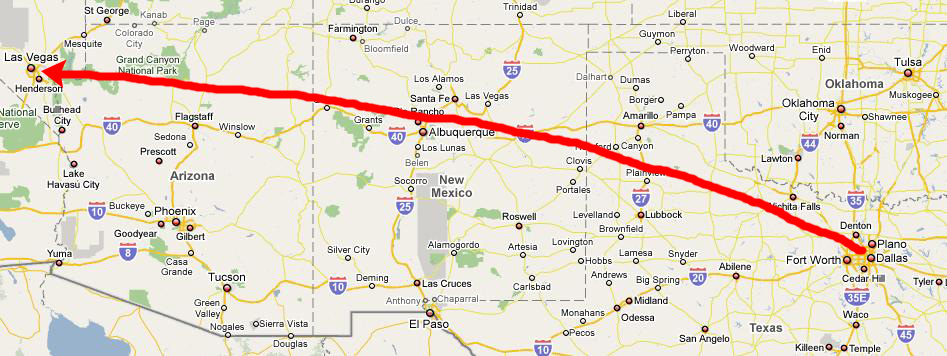
We took off right on time at 7:15AM and thirty minutes later were at our cruising altitude. No Kahlua and cream this early, but they did serve us a nice breakfast- omelette, fruit and country biscuit. The flight was a very nice one, about three hours long, but it wasn't until the last 45 minutes that Fred was able to get any good pictures.
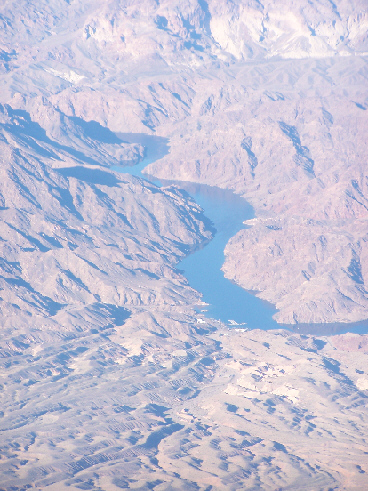 |
Minutes later, the plane came in over the Las Vegas basin to land at McCarran International Airport. At this airport, midfield concourses are linked to the main terminal building by a tram system. So we had to walk down the concourse to the end, go downstairs and board the tram and let it carry us on the one-minute ride to the main terminal. (Actually, the announcements weren't quite clear, and when we got to the main terminal the first time, we didn't realize that's where we were supposed to get off, so we rode right back to the concourse we came from. But you couldn't fool us a second time, and we weren't the only ones fooled.)
Eventually, we reached the main terminal and headed down to baggage claim to sit down and wait for Steve and Mario. I spent the time scoping out taxis and shuttles. About thirty minutes later, Steve and Mario arrived.
 |
(I might mention here that while we were in the cab, Steve happened to lean forward to get a brochure out of the seat pocket behind the driver and in doing so, he dropped his cell phone. He did not miss it until later that day, and we pretty quickly concluded that the cab was a likely place for it to have been lost. That evening, Steve called the cab company, found that they had his phone and, the next day when Ron and Jay had arrived and picked up a car, we went over to get it.)
Our Room at the MGM Hotel
 |
The original MGM Hotel was up by Flamingo Road, and it was built in 1973. It quickly became outmoded and so, to keep up with the Joneses, the MGM Company sold it to Ballys, and it is now the Ballys Hotel and Casino. The MGM Company bought the old Marina Hotel which sat on a nice plot of land at the corner of Las Vegas Boulevard and Tropicana Avenue. They kept the 12-storey Marina Tower, but tore down everything else and built the four-winged MGM Grand in its place. The new hotel opened in 1993, and was completely renovated in 2005.
The wing where all our rooms were (and they were all on the same floor) is the one that butts up against the old Marina Hotel building. Consequently, because we were on the tenth floor, we could walk all the way west on our hall (the decor changed abruptly where we entered the older Marina building) to a set of elevators at the west end which took us right down to the small street that leads to the residences just north of the hotel and from there to Las Vegas Boulevard. This was a lot quicker than navigating our way through the gaming floor!
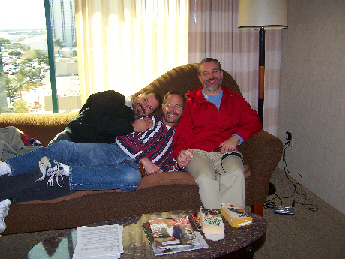 |
We had a king-size bed, a really nice bathroom and flat-screen TV. The room was decorated with pictures of MGM stars, such as Clark Gable. There was also a great work desk, so I could leave the laptop set up throughout our stay.
Walking the Las Vegas "Strip"
Las Vegas: The Early Years
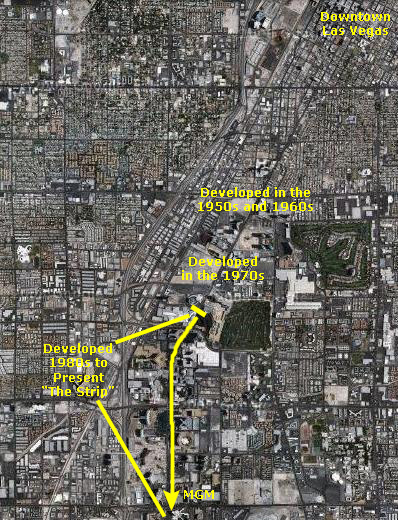 |
Almost all of the original hotels and gambling houses (and all the support "activities") had originally be located downtown, and mostly on Fremont Street. But when Las Vegas came to be more popular as a tourist destination, developers found that land downtown was too scarce, and so they moved down Las Vegas Boulevard to the south. The Desert Inn, the Sands and many other iconic Las Vegas hotel/resorts were built about two miles down the boulevard. In the 1960s and 1970s, hotels like the Sands, Caesar's Palace and others drew headliners from Los Angeles and New York, and an entertainer was certainly thought have "made it" if he got a headline gig in town. You can, I am sure, remember the huge signs that used to line the street, advertising the headliners (Dean Martin, Johnny Carson, Liberace, and many, many others) and hawking the buffets and other attractions. Las Vegas attracted more and more visitors, as it was the only place in this country where gambling was legal (and just about everything else was "available").
But Las Vegas faced new challenges and changes in the 1980s. Other states began to wonder why all their residents were traveling to Las Vegas to lose money; they thought that money should stay at home. New Jersey, with its Atlantic City, was the first to challenge Las Vegas in a big way. But following hot on its heels were state lotteries and other forms of legalized gambling, horse racing and sports betting. And that's not even to mention the more recent development that has seen just about every Indian tribe in the country bring in developers and managers to run casinos on their sacred lands. Dallasites used to have to go to Vegas to gamble; now we can either drive 80 miles into Oklahoma to the Choctaw Casino, or 160 miles to Shreveport/Bossier City, Louisiana, for Las Vegas-style casinos.
Las Vegas' solution was to build bigger and better, to clean up its act (read: moderate the Mob influence) and to re-brand itself as a "family-friendly" vacation destination. Thus began the era of the "mega-casinos." One after another, the iconic hotels were demolished and their land used to build bigger and bigger hotels and resorts. And this trend has only accelerated into the twenty-first century. The MGM is a good example. It was built in 1973 by fabled Las Vegas promoter and multi-millionaire Kirk Kerkorian near where Las Vegas Boulevard curves to the northeast. It had 2000 rooms and was the largest hotel in the world by number of rooms. Fifteen years later, that mega-casino, mega-hotel was already out-of-date. The MGM Company sold the hotel to Bally's (who completely renovated it), moved all the way down the Strip to the corner of Las Vegas Boulevard and Tropicana, and built a 4000-room hotel, huge casino and an entire theme park (to attract families). Ten years later, they had to add on another thousand rooms, just to keep up. (It is now the world's second-largest hotel, but will reclaim the title when the next Signature tower opens.)
Las Vegas: The Age of the Mega-Casino
 |
And these aren't just hotels; they are "themed environments." Some of their themes are obvious given their names- Paris, The Venetian, The MGM Grand, Caesar's Palace and Circus, Circus to name just a few. Others have older, venerated names, and tend to be smaller and more oriented to basic gambling- such as Bally's, Harrah's, The Riviera and The Tropicana. Still others are more exotic. New York, New York recreates Manhattan, complete with an Empire State Building and a Statue of Liberty. In the Monte Carlo, you'd think you were in the south of France. In Bellagio, you are in the Tuscan countryside. At The Luxor you are, literally, in a huge pyramid and the theme is totally Egyptian.
And its not just the buildings and the themes that attract people. Bellagio has one of the world's largest electronically-controlled fountain systems in a lake right on the boulevard in front of the hotel. New York has a humongous roller coaster (not to mention a Nathan's Hot Dog outlet). Circus, Circus has a 24-hour circus going on in the middle of the casino (and the building is ingeniously-designed so that only adults can get to the gaming floors while kids can wander through the circus area and the arcades). At Treasure Island, you can watch two pirate ships go at it every two hours in a simulated Caribbean harbor.
Hoteliers have also attempted to attract visitors with more cerebral offerings. Mandalay Bay has a large aquarium that takes a couple of hours to get through. The Bellagio has a botanical garden right in the building. The MGM Grand has a movie museum, and the Monte Carlo has a world-class art museum (as does The Wynn). The shows, too, have gone high-tech and upscale. The last of the traditional Las Vegas Showgirl Revues will close this year, and "headliners" are not so prevalent as they once were. They have been replaced almost entirely by Cirque de Soliel in one of its six or eight incarnations, all of which show at various hotels in permanent theatres built specifically for them. Famous entertainers, such as Celine Dion, also had theatres built specifically for them (hers at Caesar's Palace), and these entertainers tend to stay for years. (Celine just left after four years, to be replaced by Cher.) Magicians are as popular as ever, as are shows like "The Chippendales" and its Australian counterpart "Thunder from Down Under." (Hey, I didn't think up these names!) Lastly, perhaps due to the aging of the general population, "tribute" shows have become very popular. These shows are peopled by impersonators who sing and dance as good as (or in at least one case, better than) the originals (some of whom are dead and some of whom are alive). One show, "Barbra and Frank" brings Barbra Striesand together with Frank Sinatra (both impersonators, of course).
Las Vegas: The "Strip" Today
 |
A half-file south is Treasure Island, which is connected to its sister hotel, the Mirage, by a tram that we took one evening. Treasure Island is the site for the Volcano Show (a light and fire show on an artificial volcano at between the hotel and the boulevard) and the Mirage was the venue for Beatles "LOVE" by Cirque. On the other side of the street is the Venetian and Harrah's, the latter being the venue for the "Legends" Show.
Continuing south, the huge Caesar's Palace complex is on the west side of the boulevard; it was the venue for Celine Dion and is now the venue for Cher. Not on the strip and west of I-15 is the Rio, which was the location for the Chippendales show that we saw the same night we saw "LOVE." Back on The Strip, the Flamingo houses the large outdoor garden that we visited, and Bill's, a small, western-themed hotel, was where we ate after seeing the "Legends" show.
Across Flamingo Avenue going south is Ballys, which used to be the MGM. It is connected to Paris to the south via an indoor shopping arcade that we wandered through one afternoon. Across the street is the Bellagio, which has the huge outdoor fountain system in the small lake between the boulevard and the hotel proper. This is also the hotel with the botanical garden inside it. And back on the other side of the street is Planet Hollywood, a smallish but tall hotel tower with an attached shopping mall right on the boulevard.
Between Bellagio and Monte Carlo is the new "City Center" mega-development with offices, condos, apartments a new casino and lots of supporting businesses. We did not go into the Monte Carlo this time and saw no shows there. Then we come to "The Crossroads," the name given to the corner of Las Vegas Blvd. and Tropicana Ave. Four of the largest and most famous of the newer hotels are located here: New York, New York on the northwest corner, the MGM Grand on the northeast, the Tropicana on the southeast and Excalibur on the southwest. All four of these hotels are connected by outdoor elevated pedestrian crosswalks, and all except the Tropicana can be reached via entrances at crosswalk level. You'll see many pictures of these elevated crosswalks when you visit these four hotels here in the photo album. (Hooters is just west of the Tropicana. It is adjacent to the restaurant where we ate breakfast twice, is the old San Remo hotel where we stayed in 1999.)
Finally, south of Excalibur you have the Luxor and Mandalay Bay. All three of these hotels are connected via a continuous shopping arcade that begins off the Excalibur gaming floor, goes right through the Luxor and ends in Mandalay Bay. There are virtual-reality rides in the Luxor that we've done before, and the Mandalay Bay houses the Shark Reef Aquarium that we visited on this trip.
Daytime Photos of the Las Vegas Strip
As much as I can, I'll put the daytime images in order from the Crossroads heading north (since we walked inside from Excalibur south to Mandalay Bay, I don't have any street pictures south of the Crossroads); I will just put the nighttime images in a separate group. In each group, if you will click on the thumbnail images you can see the full-size pictures:
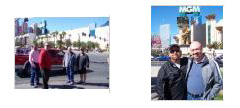
|
The second (Ron and Jay) was taken near the corner of Tropicana and Las Vegas Blvd., and looks beyond the MGM Grand and north.
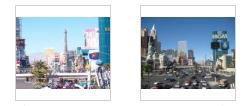
|
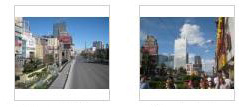
|

|
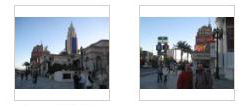
|

|

|
A lot has been transplanted from other places to Las Vegas- Paris, Monte Carlo, Egypt and New York. In simulations, of course. When New York arrived, something else came with it- something very familiar to New Yorkers as they walk along 42nd Street or through Times Square. It's the hawkers for clubs and bars. These hawkers hand out cards, passes and flyers advertising one bar or another, although in Las Vegas, its mostly girls for hire. Both in New York City and here, they have developed a distinctive way of flipping the cards to passersby, "clicking" the top one off a stack to attract attention and then holding it out for the person to take. Not many people take them, but that hasn't seemed to put a dent in the number of these kids (mostly young and mostly Hispanic but probably all required to be over 21) performing this "service." We saw at least a hundred of them between the MGM Grand and Harrah's, on both sides of the street. After a while, it gets a bit annoying; they crowd the sidewalks and slow everything down and the clicking sound can get deafening. If you want to see what I mean, watch the movie below:
|
This movie will show you just what it was like to walk past a phalanx of these hawkers. Actually, they were all up and down the Strip, and it was impossible not to walk by tens of them in any short distance. |
Nighttime Photos of the Las Vegas Strip

|
I took two nighttime movies on The Strip:
|
This movie shows the beautiful electronic displays outside the shopping arcade of the Planet Hollywood Hotel; these displays face the Strip. |
This movie was taken from New York, New York, and shows the four major hotels at the intersection of The Strip and Tropicana Boulevard- known locally as "the Crossroads." The hotels are the MGM Grand, the Tropicana, Excalibur and, of course, New York, New York. |
Hotel #1: The New York, New York Hotel and Casino
Aerial View and Location
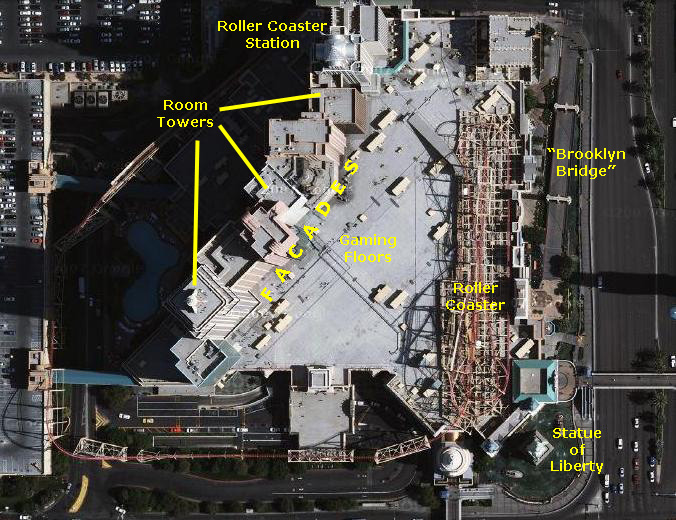 |
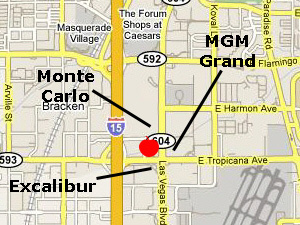
In the aerial view at left, you can pick out some of the features of the hotel complex that you will see frequently in the pictures that we took of it. The most prominent feature, of course, are the facades for iconic New York buildings. These facades mask the actual hotel towers. Unlike most of the other hotels on the strip, New York, New York is not composed of a single (or multiple) towers that are identical. Instead, at New York, New York there are multiple towers linked together, each in a different shape (although the number of different shapes does not correspond exactly to the facades placed on the towers). Because of this, and because the room windows have to correspond with the particular facade, the interior layout of the rooms is more varied and complex, with the result that the various room types are all arranged very differently- with lots of angles, nooks and crannies (as the pictures on the hotel Web site show). You can also pick out the Statue of Liberty and the Brooklyn Bridge replica alongside the hotel on Las Vegas Blvd. At ground level, pedestrians can walk across it.
Description
|
History
Attractions
 |
New York-New York is also home to Zumanity, the third show from Cirque du Soleil to take up permanent residence in the Las Vegas area and the first to be directed primarily toward adult audiences. It is the only permanent Cirque show to allow admission only to those over 18 years of age. The theatre is arranged as a cabaret, with sofas and bar stools complementing the standard theatre seats. The Master of Ceremonies for the show is Joey Arias, a drag queen hailing from New York City.
Picture Gallery

|

|

|
Hotel #2: The Planet Hollywood Hotel and Casino
Aerial View and Location
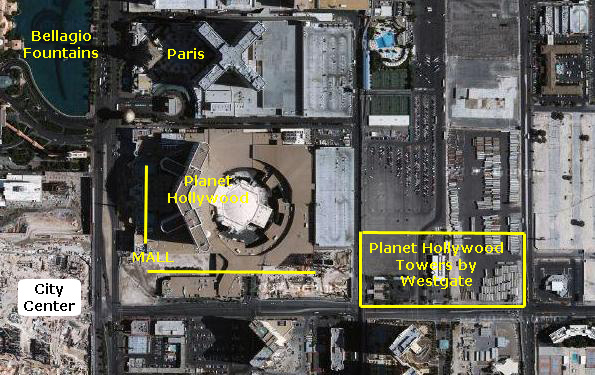 |
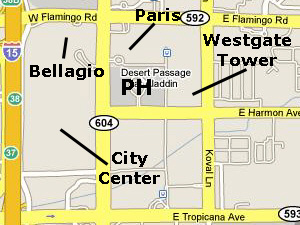
In the aerial view at left, you can see the main building of the hotel and casino, and perhaps also pick out the buildings of the large shopping mall that surrounds it on two sides. You will not be able to pick out the new Westgate Towers; ground had not been broken for them when the aerial view picture was taken. You can also see the Paris property just to the north, and the lagoon in front of Bellagio across the street. You can also see a portion of the huge construction site for the City Center development.
Description
|
History
The Aladdin opened on April 1, 1966, with an innovative main showroom policy that offered three completely different shows twice nightly with no cover or minimum charges and a 9-hole golf course. A little more than a year after it was opened, the Aladdin was host to Elvis and Priscilla Presley's wedding. It was sold again in 1969, and the new owners conducted a $60 million face lift, including the addition of a 19-story tower and the new 7,500 seat Performing Arts Center. It had a grand re-opening in 1976 with singer Neil Diamond being paid $750,000 for two shows.
The Aladdin closed on November 25, 1997. On April 27, 1998, the entire resort was imploded, except for the Aladdin Theatre, to make way for the construction of an entirely new casino. The Aladdin was scheduled to reopen on August 17, 2000, at 6:00pm, with fireworks at 10:00pm, but the opening was delayed 24 hours due to last-minute repairs to the casino surveillance system and the building inspection. A great many visitors and guests had to be accommodated elsewhere.
Meanwhile, the Desert Passage mall was opened with I Dream of Jeannie star Barbara Eden opening the doors to let the large crowd in. The Aladdin finally opened the next day at 7:45am. The casino was in financial trouble from the start and was sold on June 20, 2003, to a partnership of Planet Hollywood and Starwood Hotels & Resorts Worldwide. Renovations were carried out in stages, allowing the resort to remain open throughout. Planet Hollywood Las Vegas includes an expanded casino, new restaurants, new nightclub and retail space. A redesign of the facade and pedestrian plaza was intended to correct defects that made accessing the property from the sidewalks on The Strip difficult.
"The Desert Passage" has been converted into the new, Hollywood themed "Miracle Mile Shops." The official grand opening of Planet Hollywood Casino and Resort was the weekend of November 16, 2007. The Planet Hollywood restaurant, however, remains at The Forum Shops at Caesars.
Picture Gallery

|
Hotel #3: The Flamingo Hotel and Casino
Aerial View and Location
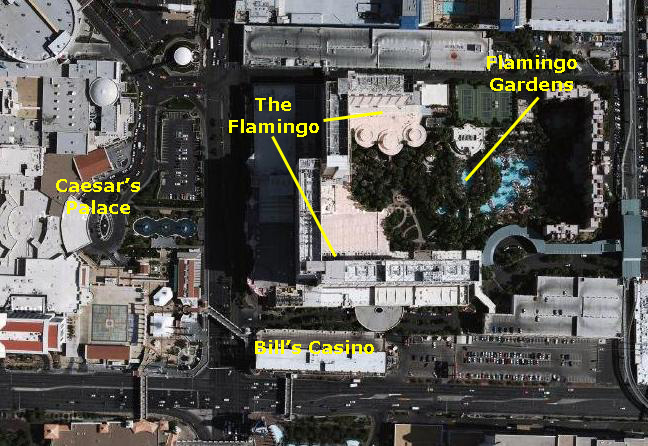 |
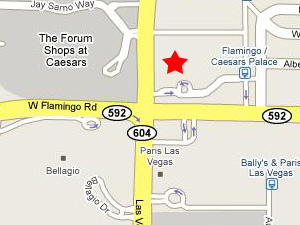
In the aerial view at left, you can see the main building of the hotel and casino; it forms a U-shape with the main casino floor and the hotel tower on the south end, connected with the shopping arcade and some restaurants in the middle to the buffet and a club on the north end. Nestled inside the U-shape are the Flamingo Gardens, an area of waterfalls and pools where flamingos and birds wander around and tropical and koi fish populate the pools and streams. This is also the area where the pools for the hotel are located.
Description
|
History
Wilkerson's goal for the casino was to design an ultra-gambling experience, a complete escape that allowed gamblers to indulge their passion in palatial luxury, and his ideas persist throughout almost every casino in town. Elements he originated including (1) placing the casino at the center of the hotel making it almost impossible to move around the property without passing through it, (2) eliminating windows, (3) banning clocks and (4) permanently dimming the lights. These elements, Wilkerson argued, would mask and conceal the true time of day, ensuring that time passed largely unnoticed. Wilkerson also wished to make the gambling experience as comfortable as possible. Before 1945, most gaming tables had hard edges. Wilkerson ordered custom gaming tables with curved edges and leather cushioned padding around the sides for extra comfort. He also felt standing diminished the pleasure of the game. Chairs and stools would be mandatory at every table. Wilkerson's project would be the first hotel in the U.S. to utilize the latest innovation in indoor cooling - air conditioning. With it, the desert would at long last become genuinely habitable.
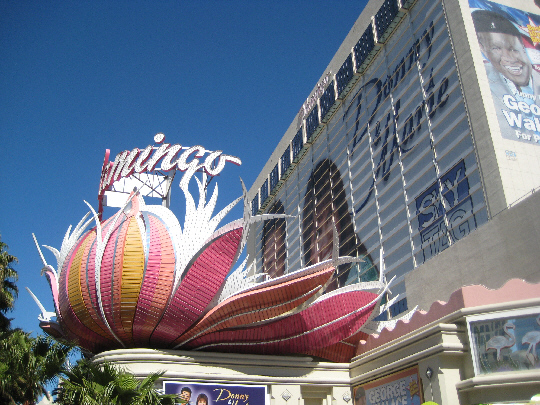 |
Siegel didn't remain silent for long, and brought all of his gangster characteristics to the project. Siegel began to operate on his own, in his familiar role- the big-shot. On June 20, 1946, Siegel formed the Nevada Project Corporation of California, naming himself as president. From this point on the Flamingo became effectively a syndicate-run operation. He launched an all-out spending spree that was staggering even by today's standards. By October 1946, the project's costs had soared above $4 million.
Siegel finally opened The Flamingo, at a total cost of $6 million, on December 26, 1946. Billed as The West's Greatest Resort Hotel, the 105-room property became the first luxury hotel on The Strip. The splashy opening with entertainment including Cuban band leader Xavier Cugat, George Jessel, Rose Marie, and Jimmy Durante — was a flop. Siegel had also been overly optimistic about the revenues the Flamingo would bring in on opening night. A major reason why the casino lost money when it opened was because there were no hotel rooms available to keep guests gambling after hours. Gamblers and guests alike took their winnings elsewhere. After two weeks of operation the Flamingo's plush gaming tables were $275,000 in the red and ended up shutting down the entire operation in late January 1947. Lansky managed to persuade the mob chiefs to reprieve Siegel once more and allow the Flamingo more time.
The Flamingo re-opened in March despite the hotel not being complete, and this time, the results proved different. By May, the resort reported a $250,000 profit, allowing Lansky to point out that Siegel was right about Las Vegas, after all. But it wasn't quite enough to save Siegel. On June 20, 1947, relaxing in the Hollywood bungalow he shared with Virginia Hill, who was away at the time, Siegel was shot to death. No one was ever charged with the murder, and the crime remains unsolved.
Casino management changed the hotel name to The Fabulous Flamingo on March 1, 1947, and in time the Flamingo presented lavish shows and accommodations for its time, becoming well known for comfortable, air conditioned rooms, gardens, and swimming pools. Often credited for popularizing the "complete experience" as opposed to merely gambling, the Flamingo staff became known for wearing tuxedos on the job, and in 1950 the resort's Champagne Tower opened. Kirk Kerkorian acquired the property in 1967, but the Hilton Corporation bought the resort in 1972, renaming it the Flamingo Hilton in 1974. The last of the original Flamingo Hotel structure was torn down on December 14, 1993 and the hotel's garden was built on the site.
Picture Gallery
Miscellaneous Pictures:

|
|
To view the slideshow, just click on the image at left and I will open the slideshow in a new window. In the slideshow, you can use the little arrows in the lower corners of each image to move from one to the next, and the index numbers in the upper left of each image will tell you where you are in the series. When you are finished looking at the pictures, just close the popup window.
I also made two good movies while here at the Flamingo:
|
This movie was made as we came into the gardens in the interior of the Flamingo Hotel, and shows the expanse of the area. |
This movie shows some of the artificial streams and the bridges across them. You'll also see the way the surrounding buildings use the gardens as their scenery. |
The New Las Vegas City Center Development
Aerial View and Location
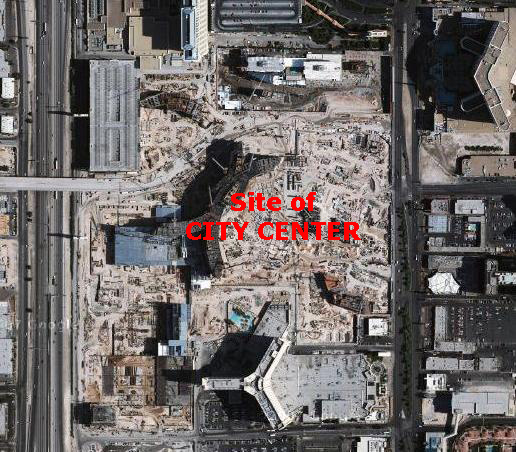 |
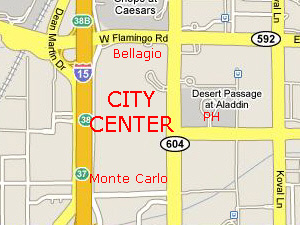
When you look at the pictures below, you will see that the development is much farther along than the aerial view indicates. It would seem that the aerial view is at least a year old.
Description
|
History
With a total cost of approximately $11 billion, CityCenter is the largest privately financed development in the United States. The original cost estimate was $4 billion, but it was pushed up by rising construction costs and design changes. CityCenter is expected to open with approximately 12,000 employees and is planned to open in phases beginning in August 2009.
The last remaining permanent building on the project site, the Boardwalk Casino's mid-rise hotel tower, was imploded May 9, 2006. After most of the design process was complete, construction began without an official groundbreaking ceremony in June 2006. Most renderings of the project were released in September 2006 and some delayed until February 2007. Construction started taking shape on June 26, 2006, when the first concrete was poured. Prior to this all of the work was site preparation, including utilities and other infrastructure.
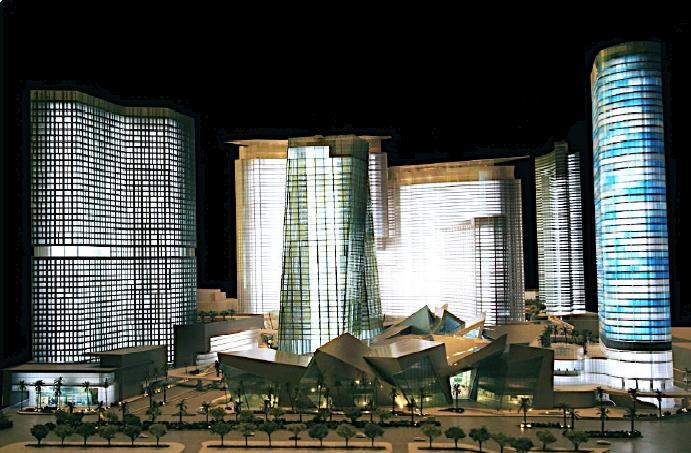 |
Vdara will be the complex's only condo-hotel, located between the ARIA Resort & Casino and the Bellagio. Its 57-story tower will house 1,543 residential units, ranging from 500 to 2000 sq.ft. It is scheduled to open in October 2009 and was the first of the six high rises in the project to be topped out (May 14, 2008). The Harmon Hotel and Spa will be a 28-floor, non-gaming boutique hotel with an elliptical layout located on the northeast corner of the project at the intersection of Las Vegas Boulevard South and Harmon Avenue. The hotel's pool deck will be perched 100 feet above the Strip. The tower is planned to have 400 rooms. (it was to have another 21 floors of condominium residences, but when inspectors discovered improper installation of critical steel reinforcements, those 21 floors had to be eliminated. The building has been delayed past the other CityCenter projects and is scheduled to be finished in 2010.
 Veer Towers |
The Veer Towers will be two towers leaning in opposite directions (five degrees from center) that will rise adjacent to The Crystals retail district (see picture at right). The twin 37-story towers will each house 337 luxury condominium units ranging from 500 to 1,500 sq.ft. Atop each tower, there will be an amenities floor including a pool, fitness center, spa, cabanas and a patio for outdoor entertaining.
CityCenter's 500,000 sq.ft. retail/entertainment area, The Crystals, will feature fashionable clubs, gourmet restaurants, retailers, galleries, incidental offices and support areas. For the interior architecture, the Rockwell Group will create an experiential environment that complements the overall city scene. This neighborhood of retail shops, dining and entertainment venues will form the core of this project. There will be a flagship 20,000-sq.ft. Apple Store located within Crystals.
The project also includes several support structures including a fire station, an on-site power plant, and a 6,900 car parking garage.
Picture Gallery
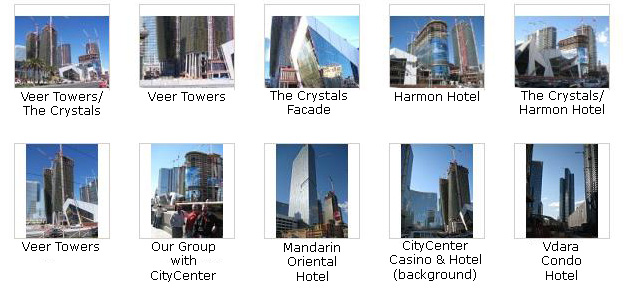
|
|
I made this movie as we were walking by the CityCenter development, to try to take it all in and give you a good idea of what it was like. It is going to be a spectacular development when it is done. |
The "Legends" Tribute Show at Harrah's
Hotel #4: Harrah's Hotel and Casino
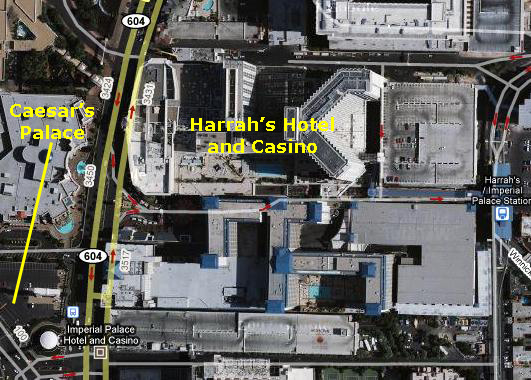 |
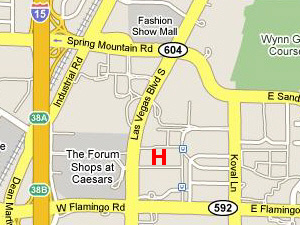
The property is owned and operated by Harrah's Entertainment; they also own casinos in Atlantic City and Shreveport-Bossier City over in Arkansas. The hotel consists of several towers, the tallest of which has 35 stories. The courtyard entry houses a Ghirardelli Chocolate Company store. There is a Las Vegas Monorail stop at the rear of the property, and a free shuttle to the Harrah's-owned Rio.
|
In 1997, Harrah's renovated the property, removing the old theme and replacing it with a carnival party theme. They extended the 35 story tower by adding 986 rooms. Included in the renovations were six giant 22,000 pound 23-karat gold-leaf jesters. Built from steel and glass reinforced polyester resin, the jesters stand 32 feet high and wear size 43 shoes.
At the grand re-opening Harry Connick, Jr. entertained at the Carnival Court. Tino Wallenda, son of legendary tight-rope walker Karl Wallenda, walked 139 ft across a 1-inch steel cable, 99 feet above the ground. Celebrities who also appeared included Sidney Poitier, Sandra Bullock, Minnie Driver, Stephen Baldwin, Lea Thompson, Mike Bergin, Dick Butkus and Steve Wynn.
We didn't take many pictures of Harrah's; it isn't one of the new mega-properties. But we did get some good shots on Thursday afternoon when we were walking on The Strip. Click on the thumbnail images below to see these pictures:

|
The "Legends" Show
 |
When we first discussed coming to Las Vegas, Mario, the music critic for the Dallas Morning News, told his editor that he was going, and she suggested that he combine business with pleasure and review some of the shows that were running. They settled on the general topic of "tribute" shows. If you don't know what a tribute show is, it is basically a performer who looks and sounds like someone famous- like the ubiquitous Elvis impersonators. I wasn't quite sure what to expect, but Mario had worked hard with a publicist in town to get us tickets to three such shows. Tonight is the first of them: The "Legends" Show at Harrah's Hotel and Casino.
Before and during the show, I thought that the Legends show only had the six performers that we saw, but I learned from Mario later that there were actually more different performers and that they rotated to keep the show fresh and keep people coming back. But it wasn't until I visited the Website for "Legends in Concert" that I learned just how big an organization it is. As it turns out, there are multiple shows running simultaneously around the world. Some are in fixed locations, as here at Harrah's, some tour and some are privately engaged. It is a huge operation.
For our show, we saw six performers, and here they are:
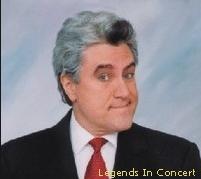 |
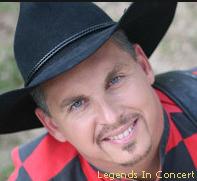 |
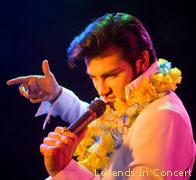 |
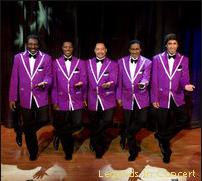 |
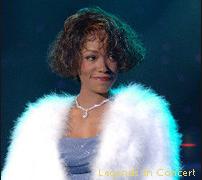 |
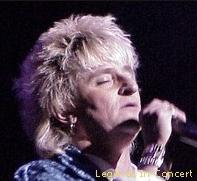 |
(Of course, they are Jay Leno, Garth Brooks, Elvis Presley, The Temptations, Whitney Houston and Rod Stewart.)
“Legends in Concert” is the longest running celebrity tribute show in the world, and features live re-creations of superstars of yesterday and today and backed by a live orchestra and dancers. Prior to moving to Harrah's in December, 2008, the successful production has called the Harrah’s Entertainment-owned Imperial Palace its Las Vegas home.
The concert itself was certainly enjoyable and, with only minor exceptions and the occasional closing of one's eyes, you would actually believe that you are hearing the original artists. Oddly enough, the only one I thought didn't quite ring true was the Elvis Presley impersonator, but then I never really got "into" Presley enough to be an expert.
Flash photography was prohibited in the theatre, as was any kind of movie-making equipment. We had excellent seats right down near the front, but that was unfortunate for it meant that if we tried to film parts of the production, anyone behind us would have been able to tell, so we refrained. Steve did try to take some pictures, but only two of them are even passable- this one of "Garth Brooks" and this one of "Elvis".
When the show was over, we walked back down The Strip to the MGM Grand. On the way, we picked up a message from Ron and Jay who told us that they'd been delayed in Minneapolis and would not be arriving in time to have dinner with us, so the four of us stopped in Bill's Casino and had a late supper in the restaurant. When we got back to the MGM, Fred and I walked outside again to take some of the night pictures that you'll see sprinkled through these album pages. We were pretty tired after that, so it was back to our very nice room and bed.
You can use the links below to continue to another album page.
 |
March 6, 2009: Las Vegas Trip Day 2 |
 |
Return to the Index for Our Las Vegas Trip |